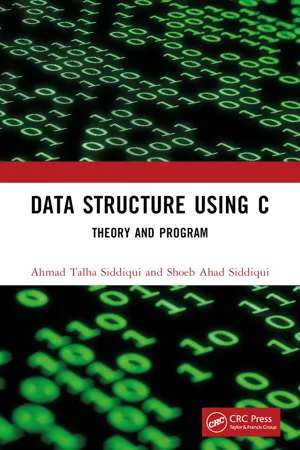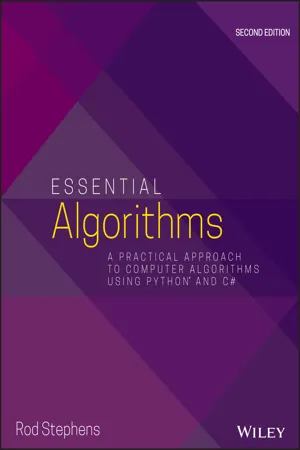Computer Science
Binary Tree
A binary tree is a data structure composed of nodes, where each node has at most two children, referred to as the left child and the right child. The topmost node is called the root. Binary trees are commonly used in computer science for efficient searching and sorting algorithms, and they provide a foundation for more complex data structures like binary search trees and AVL trees.
Written by Perlego with AI-assistance
Related key terms
1 of 5
12 Key excerpts on "Binary Tree"
- eBook - PDF
- Anil Kumar Yadav, Vinod Kumar Yadav(Authors)
- 2019(Publication Date)
- Arcler Press(Publisher)
Common Application of Trees • Manipulate hierarchical data • Make information easy to search • Manipulate sorted lists of data • Classification of data • Useful for representing an expression. • Useful in decision making in game theory. 7.3. Binary Tree Binary means maximum two, a tree is a special type of data structure in which the number of children of any node is restricted to almost two. A Binary Tree is a finite set of an element that is either empty or is partitioned into three disjoint subsets. The first node contains a single data called the root of the tree. The further two subtrees are Binary Trees, called the left and right subtrees of the original tree. The Binary Tree ‘BT’ may also have zero nodes and can be defined recursively as: • An empty tree is a Binary Tree. • A distinguished node (unique node) known as the root node. Data Structures with C Programming 166 • The remaining nodes are divided into two disjoint sets ‘L’ and ‘R,’ where ‘L’ is a left sub-tree and ‘R’ is right subtree such that these are a Binary Tree once again. Figure 7.4: Binary Tree. 7.3.1 Strictly Binary Tree A Binary Tree is called a strictly Binary Tree if every non-leaf or terminal node in the Binary Tree has nonempty left and right subtree. It means that each node in a tree will have either 0 or 2 children. Figure 7.5 shows (a), (b) and (c) strictly Binary Tree. Figure 7.5 : Strictly Binary Tree. 7.3.2. Almost Complete Binary Tree A Binary Tree of depth d is an almost complete Binary Tree if- Any node at level less than d – 1 has two sons and any node in the tree with a right descendent at level d, node should have a left son and each left descendant of node is either a leaf at level d or has two sons. Figure 7.6 shows almost complete Binary Tree. Tree 167 Figure 7.6: Almost Complete. 7.3.3. Complete Binary Tree A complete binary is a tree in which all non-terminal nodes have degree 2 and all terminal nodes are at the same depth. - eBook - PDF
- Shi-kuo Chang(Author)
- 2003(Publication Date)
- World Scientific(Publisher)
Chapter 11 Binary Trees SANGWOOK KIM Kyungpook National University, Korea [email protected] We can represent any tree as a Binary Tree. Binary Trees are an important type of tree structure. In this chapter, we study Binary Tree as data struc-ture using the linked list for their implementation. Binary Tree is a valuable data structure for a range of applications in computer science. 11.1. Binary Tree In this section, we study the definition of the Binary Tree that can illustrate the behavior of some algorithms like sorting and searching. Especially, we have used comparison trees showing the comparison keys in searching. 11.1.1. Definition and Properties A Binary Tree is different from a tree. Binary Trees have characteristics that any node can have at most two branches. Thus, we distinguish between the subtree on the left and the subtree on the right for Binary Trees. Also a Binary Tree may have zero nodes. Definition. A Binary Tree is either empty, or it consists of a root and two disjoint Binary Trees called the left subtree and the right subtree. Before we consider general characteristics of Binary Tree, we can construct small Binary Trees by recursion. 225 226 S. Kim Fig. 11.1. A Binary Tree with one node and two different Binary Trees with two nodes. Fig. 11.2. Binary Trees with two nodes in left subtrees. (1) If the number of nodes is zero, there is an empty Binary Tree. (2) If the number of nodes is one, there is only a Binary Tree with root node that both left and right subtrees are empty. (3) If the number of nodes is two, one node on the tree is the root and another is in a subtree. In this case, one of the left and the right subtrees must be empty, and the other subtrees have exactly one node. Thus we have two different Binary Trees with two nodes. In the Binary Tree, since the left and right are important, Binary Trees with two nodes in Fig. - 581 C H A P T E R 17 TREE STRUCTURES C H A P T E R G O A L S To study trees and Binary Trees To understand how binary search trees can implement sets To learn how red-black trees provide performance guarantees for set operations To choose appropriate methods for tree traversal To become familiar with the heap data structure To use heaps for implementing priority queues and for sorting C H A P T E R C O N T E N T S © DNY59/iStockphoto. 17.1 BASIC TREE CONCEPTS 582 17.2 Binary TreeS 586 WE1 Building a Huffman Tree 590 17.3 BINARY SEARCH TREES 590 17.4 TREE TRAVERSAL 599 17.5 RED-BLACK TREES 605 WE2 Implementing a Red-Black Tree 611 17.6 HEAPS 612 17.7 THE HEAPSORT ALGORITHM 622 582 © DNY59/iStockphoto. In this chapter, we study data structures that organize elements hierarchically, creating arrangements that resemble trees. These data structures offer better performance for adding, removing, and finding elements than the linear structures you have seen so far. You will learn about commonly used tree-shaped structures and study their implementation and performance. 17.1 Basic Tree Concepts In computer science, a tree is a hierar- chical data structure composed of nodes. Each node has a sequence of child nodes, and one of the nodes is the root node. Like a linked list, a tree is composed of nodes, but with a key difference. In a linked list, a node can have only one child node, so the data structure is a linear chain of nodes. In a tree, a node can have more than one child. The resulting shape resembles an actual tree with branches. However, in computer science, it is customary to draw trees upside-down, with the root on top (see Figure 1). Austrian Archives/Imagno/GettyImages, Inc. A family tree shows the descendants of a common ancestor. A tree is composed of nodes, each of which can have child nodes. The root is the node with no parent. A leaf is a node with no children.
- No longer available |Learn more
Data Structures and Program Design Using C
A Self-Teaching Introduction
- D. Malhotra, N. Malhotra(Authors)
- 2018(Publication Date)
- Mercury Learning and Information(Publisher)
• Depth – It is given as the length of the path from the root node to the destination node. 8.3 Binary Tree A Binary Tree is a collection of nodes where each node contains three parts, that is, left pointer, right pointer, and the data item. The left pointer points to the left subtree and the right pointer points to the right subtree. The topmost element of the Binary Tree is known as a root node. The root pointer points to the root node. As the name suggests, a Binary Tree can 348 • DATA STRUCTURES AND PROGRAM DESIGN USING C have at most two children, i.e., either a parent can have zero, one, or at most two children. Also, if root = NULL, then it means that the tree is empty. Figure 8.9 represents a Binary Tree. In the following figure, A represents the root node of the tree. B and C are the children of root node A. Nodes B, D, E, F, and G constitute the left subtree. Similarly, nodes C, H, I, and J constitute the right subtree. Now, nodes G, E, F, I, and J are the terminal/leaf nodes of the Binary Tree as they have no children. Hence, node A has two successors B and C. Node B has two successors D and G. Similarly, node D also has two successors E and F. Node G has no successor. Node C has only one successor H. Node H has two successors I and J. Since nodes E, F, G, I, and J have no successors, they are said to have empty subtrees. FIGURE 8.9. A Binary Tree. 8.3.1 Types of Binary Trees There are two types of Binary Trees: 1. Complete Binary Trees – A complete Binary Tree is a type of Binary Tree which obeys/satisfies two properties: a. First, every level in a complete Binary Tree except the last one must be completely filled. TREES • 349 b. Second, all the nodes in the complete Binary Tree must appear left as much as possible. In a complete Binary Tree, the number of nodes at level n is 2 n nodes. Also, the total number of nodes in a complete Binary Tree of depth d is equal to the sum of all nodes present at each level between 0 and d. - 519 C H A P T E R 16 TREE STRUCTURES C H A P T E R G O A L S To study trees and Binary Trees To understand how binary search trees can implement sets To learn how red-black trees provide performance guarantees for set operations To choose appropriate functions for tree traversal C H A P T E R C O N T E N T S © DNY59/iStockphoto. 16.1 BASIC TREE CONCEPTS 520 16.2 Binary TreeS 524 WE1 Building a Huffman Tree 528 16.3 BINARY SEARCH TREES 528 16.4 TREE TRAVERSAL 538 16.5 RED-BLACK TREES 544 WE2 Implementing a Red-Black Tree 551 520 In this chapter, we study data structures that organize elements hierarchically, creating arrangements that resemble trees. These data structures offer better performance for adding, removing, and finding elements than the linear structures you have seen so far. You will learn about commonly used tree-shaped structures and study their implementation and performance. 16.1 Basic Tree Concepts In computer science, a tree is a hierarchi- cal data structure composed of nodes. Each node has a sequence of child nodes, and one of the nodes is the root node. Like a linked list, a tree is composed of nodes, but with a key difference. In a linked list, a node can have only one child node, so the data structure is a linear chain of nodes. In a tree, a node can have more than one child. The resulting shape resembles an actual tree with branches. However, in computer science, it is cus- tomary to draw trees upside-down, with the root on top (see Figure 1). Austrian Archives/Imagno/GettyImages, Inc. A family tree shows the descendants of a common ancestor. A tree is composed of nodes, each of which can have child nodes. The root is the node with no parent. A leaf is a node with no children. Figure 1 A Family Tree George V Edward VIII George VI Mary Henry George John Elizabeth II Margaret Richard Edward Michael Alexandra Charles Anne Andrew Edward Harry Peter Zara Beatrice Eugenie Louise Severn William Savannah
- eBook - ePub
Data Structure Using C
Theory and Program
- Ahmad Talha Siddiqui, Shoeb Ahad Siddiqui(Authors)
- 2023(Publication Date)
- CRC Press(Publisher)
If in a Binary Tree, each empty sub-tree is replaced by a special node then the resulting tree is extended Binary Tree or 2-tree. So we can convert a Binary Tree to an extended Binary Tree by adding special nodes to leaf nodes and nodes that have only one child. The special nodes added to the tree are called external nodes and the original nodes of the tree are internal nodes. External nodes are shown by square and internal nodes by circles.Fig: Extended Binary Tree3. Complete Binary Tree
In computer science, a Binary Tree is a tree data structure in which each node has at most two children, which are referred to as the left child and the right child. A Binary Tree with n nodes and a depth d is a strictly Binary Tree all of whose terminal nodes are at level d. If a Binary Tree contains m nodes at level I, it contains at most 2m nodes at level I+1.4. Almost Complete Binary Trees
A Binary Tree of depth d is an almost complete Binary Tree, if:- Any node at level less than d-1 has two children.
- For any node ‘X’ in the tree with a right descendant at level d, X must have a left child and every left descendant of X is either a leaf at level d or has two childrens.
Figure (a) , is not almost complete Binary Tree because it contains leaf fig6_231_3 at level 1, 2 and 3. So, it is violating rule 1. Figure (b) , satisfies rule 1, since every leaf is either at level 2 or at level 3. However, rule 2 is violating. Since A has a right descendant at level 3 (J) but also has a left descendant that is a leaf at level 2 (E). Figure (c) , satisfies both rules 1 and 2 and is therefore an almost complete Binary Tree.Figure: aFigure: bFigure: cAn almost complete strictly Binary Tree with n leaves has 2n-1 nodes and an almost complete Binary Tree with n leaves that is not strictly binary has 2n nodes. There are two distinct almost complete Binary Trees with n leaves one of which is strictly binary and one of which is not. An almost complete Binary Tree of depth d is intermediate between the complete Binary Tree of depth d-1 that contains 2d -1 nodes and the complete Binary Tree of depth d, which contains 2d+1 - eBook - ePub
Quick Reference to Data Structures and Computer Algorithms, A
An Insight on the Beauty of Blockchain
- Divya Joseph, Raji Ramakrishnan Nair, Divya Joseph, Alen Joseph(Authors)
- 2019(Publication Date)
- BPB Publications(Publisher)
All nodes, other than the root node, are compartmentalized into zero or more fragmented sets t1,…., tn, and each of these sets is a tree. These compartmentalized disconnected sets are called the subtrees of the root.4.4 Binary Trees
One of the important tree structure is a Binary Tree. It becomes distinctive by the fact that any node can have maximum of 2 branches i.e., the only restriction here is that, no node is available in a Binary Tree with degree greater than 2.Definition: A Binary Tree is a defined set of nodes, which can be null or comprise of a root node and two disjoint Binary Trees called the left subtree and the right sub tree.Following features of a Binary Tree and a tree, makes important differences between them:(i) There is no tree available with zero node, but there is a Binary Tree, which can be empty. (ii) Binary Trees distinguish between the sub tree on the left and on the right, whereas for trees the order of the sub trees is irrelevant. As shown in figure 4.4, when the above trees are treated as Binary Trees, then they are considered as two different Binary Trees. Whereas when they are treated as trees, then they are same.Figure 4.4 Binary Tree and tree4.4.1 Strictly Binary Tree
If every internal node (non –terminal node) has its non- empty left and right children then it is called strictly Binary Tree (figure 4.5).Here every internal node A, B, E has two non-empty left and right child, hence it is strictly Binary Tree.Figure 4.5 Strictly Binary Tree4.4.2 Complete Binary Tree
A Binary Tree, where all the nodes have both children except last node, is known as a complete Binary Tree (figure 4.6).Figure 4.6 Complete Binary TreeThe main advantage with this structure is that we can easily find the left and right child of any node and similarly parent of any child. Two nodes of a node, that is, the left child and right child, will be at position 2N and 2N+1. Similarly, parent of any node N will be (N/2).So, parent of I = (N/2) = (9/2) = 4, i.e. D. Left child of D = 2N = 2* 4 = 8, i.e. H Right child of D = 2N + 1 = 2 * 4 + 1 = 9, i.e. I - eBook - ePub
Data Structures Through C++
Experience Data Structures C++ through animations
- Yashavant Kanetkar(Author)
- 2020(Publication Date)
- BPB Publications(Publisher)
Chapter 07Trees
Of Herbs, Shrubs and Bushes
Why This Chapter Matters?
Nature is man's best teacher. In every walk of life man has explored nature, learnt his lessons and then applied the knowledge that nature offered him to solve every-day problems that he faced at work- place. It isn't without reason that there are data structures like Trees, Binary Trees, Search Trees, AVL Trees, Forests, etc. Trees are non-linear data structures. They have many applications in Computer Science, hence you must understand them comprehensively.I f large input data is stored in a linked list then time required to access the data is prohibitive. In such cases a data structure called Tree is used. This data structure is often used in constructing the file systems and evaluation of arithmetic expressions. This data structure gives a running time of O (log n) for most operations.Like linked lists, a tree also consists of several nodes. Each node may contain links that point to other nodes in the tree. So a tree can be used to represent a person and all of his descendants as shown in Figure 7-1 .Figure 7-1. A tree structure .Note that each node in this tree contains a name for data and one or more pointers to the other tree nodes. Although a tree may contain any number of pointers to the other tree nodes, a large number of have at the most two pointers to the other tree nodes. Such trees are called Binary Trees .Binary Trees
Let us begin our study of Binary Trees by discussing some basic concepts and terminology.A Binary Tree is a finite set of elements that is either empty or is partitioned into three disjoint sub-sets. The first sub-set contains a single element called the root of the tree. The other two sub-sets are themselves Binary Trees, called the left and right sub-trees of the original tree. A left or right sub-tree can be empty.Each element of a Binary Tree is called a node of the tree. The tree shown in Figure 7-2(a) consists of nine nodes with A as its root. Its left sub-tree is rooted at B and its right sub-tree is rooted at C . This is indicated by the two branches emanating from A to B on the left and to C on the right. The absence of a branch indicates an empty sub-tree. For example, the left sub-tree of the Binary Tree rooted at C and the right sub-tree of the Binary Tree rooted at E are both empty. The Binary Trees rooted at D , G , H and I - eBook - ePub
Data Structures Through C
Learn the fundamentals of Data Structures through C
- Yashavant Kanetkar(Author)
- 2020(Publication Date)
- BPB Publications(Publisher)
Chapter 07Trees
Of Herbs, Shrubs and Bushes
Why This Chapter Matters?
Nature is man’s best teacher. In every walk of life man has explored nature, learnt his lessons and then applied the knowledge that nature offered him to solve every-day problems that he faced at work- place. It isn’t without reason that there are data structures like Trees, Binary Trees, Search Trees, AVL Trees, Forests, etc. Trees are non-linear data structures. They have many applications in Computer Science, hence you must understand them comprehensively.I f large input data is stored in a linked list then time required to access the data is prohibitive. In such cases a data structure called Tree is used. This data structure is often used in constructing the file systems and evaluation of arithmetic expressions. This data structure gives a running time of O (log n) for most operations.Like linked lists, a tree also consists of several nodes. Each node may contain links that point to other nodes in the tree. So a tree can be used to represent a person and all of his descendants as shown in Figure 7-1 .Figure 7-1. A tree structure .Note that each node in this tree contains a name for data and one or more pointers to the other tree nodes. Although a tree may contain any number of pointers to the other tree nodes, a large number of have at the most two pointers to the other tree nodes. Such trees are called Binary Trees .Binary Trees
Let us begin our study of Binary Trees by discussing some basic concepts and terminology.A Binary Tree is a finite set of elements that is either empty or is partitioned into three disjoint sub-sets. The first sub-set contains a single element called the root of the tree. The other two sub-sets are themselves Binary Trees, called the left and right sub-trees of the original tree. A left or right sub-tree can be empty.Each element of a Binary Tree is called a node of the tree. The tree shown in Figure 7-2(a) consists of nine nodes with A as its root. Its left sub-tree is rooted at B and its right sub-tree is rooted at C . This is indicated by the two branches emanating from A to B on the left and to C on the right. The absence of a branch indicates an empty sub-tree. For example, the left sub-tree of the Binary Tree rooted at C and the right sub-tree of the Binary Tree rooted at E are both empty. The Binary Trees rooted at D , G , H and I - eBook - PDF
C++ Programming
Program Design Including Data Structures
- D. Malik(Author)
- 2017(Publication Date)
- Cengage Learning EMEA(Publisher)
19 CHAPTER Binary Trees IN THIS CHAPTER, YOU WILL: 1. Learn about Binary Trees 2. Learn about the basic terminologies used in Binary Trees: left and right subtrees, path, height, level of a node, leaves, and parent of a node 3. Explore various Binary Tree traversal algorithms 4. Explore how to implement the basic operations on a Binary Tree 5. Learn about binary search trees 6. Learn how to organize data in a binary search tree 7. Learn how to insert and delete items in a binary search tree 8. Explore nonrecursive Binary Tree traversal algorithms 9. Explore Binary Tree traversal algorithms and functions as parameters © HunThomas/Shutterstock.com Copyright 2018 Cengage Learning. All Rights Reserved. May not be copied, scanned, or duplicated, in whole or in part. WCN 02-300 1362 | Chapter 19: Binary Trees When data is being organized, a programmer’s highest priority is to organize it in such a way that item insertion, deletion, and lookups (searches) are fast. You have already seen how to store and process data in an array. Because an array is a random-access data structure, if the data is properly organized (say, sorted), then we can use a search algorithm, such as a binary search, to effectively find and retrieve an item from the list. However, we know that storing data in an array has its limitations. For example, item insertion (especially if the array is sorted) and item deletion can be very time-consuming, especially if the list size is very large, because each of these oper-ations requires data movement. To speed up item insertion and deletion, we used linked lists. Item insertion and deletion in a linked list do not require any data move-ment; we simply adjust some of the links in the list. However, one of the drawbacks of linked lists is that they must be processed sequentially. That is, to insert or delete an item, or simply to search the list for a particular item, we must begin our search at the first node in the list. - eBook - PDF
Fundamentals of Python
Data Structures
- Kenneth Lambert(Author)
- 2018(Publication Date)
- Cengage Learning EMEA(Publisher)
They may indicate alphabetical ordering, phrase structure, containment in a subdirectory, or any one-to-many relationship in a given problem domain. The processing of the data within trees is based on the parent/ child relationships among the data. The sections that follow focus on different types, applications, and implementations of Binary Trees. The Shape of Binary Trees Trees in nature come in various shapes and sizes, and trees as data structures come in vari- ous shapes and sizes. Speaking informally, some trees are vine-like and almost linear in shape, whereas others are bushy. The two extremes of these shapes are shown in Figure 10-6. The shape of a Binary Tree can be described more formally by specifying the relationship between its height and the number of nodes it contains. This relationship also provides information about the potential efficiency of some operations on the tree. At one extreme, a Binary Tree can be vine-like, with N nodes and a height of N – 1. (See the left side of Figure 10-6.) Such a tree resembles a linear chain of nodes in a linked list. Figure 10-6 A vine-like tree and a bushy tree Copyright 2019 Cengage Learning. All Rights Reserved. May not be copied, scanned, or duplicated, in whole or in part. Due to electronic rights, some third party content may be suppressed from the eBook and/or eChapter(s). Editorial review has deemed that any suppressed content does not materially affect the overall learning experience. Cengage Learning reserves the right to remove additional content at any time if subsequent rights restrictions require it. 289 The Shape of Binary Trees An access, an insertion, or a removal of a node in this structure would therefore be linear in the worst case. At the other extreme, consider a full Binary Tree, which contains the maximum number of nodes for a given height H. (See the right side of Figure 10-6.) A tree of this shape contains the full complement of nodes at each level. - eBook - ePub
Essential Algorithms
A Practical Approach to Computer Algorithms Using Python and C#
- Rod Stephens(Author)
- 2019(Publication Date)
- Wiley(Publisher)
CHAPTER 10 TreesThis chapter explains trees, which are highly recursive data structures that you can use to store hierarchical data and model decision processes. For example, a tree can store a company organizational chart or the parts that make up a complex machine such as a car.This chapter explains how to build relatively simple trees and provides the background that you need to understand the more complicated trees described in Chapter 11 and Chapter 12 .Tree Terminology
Tree terminology includes a hodgepodge of terms taken from genealogy, horticulture, and computer science. Trees use a lot of terms, but many of them are intuitive because you probably already understand what they mean in another context.A tree consists of nodes connected by branches. Usually, the nodes contain some sort of data, and the branches do not.NOTE
Trees are a special type of network or graph, so sometimes network and graph terms leak into discussions of trees. For example, branches are sometimes called links or edges, although those terms are more appropriate for networks and graphs. Chapter 13 and Chapter 14 have more to say about networks.The branches in a tree are usually directed so that they define a parent-child relationship between the nodes that they connect. Normally, branches are drawn as arrows pointing from the parent node to the child node. Two nodes that have the same parent are sometimes called siblings.Each node in the tree has exactly one parent node, except for a single, unique root node, which has no parent.The children, the children's children, and so on, for a node are that node's descendants. A node's parent, its parent's parent, and so on, up to the root are that node's ancestors.All of these relationship-oriented terms make sense if you think of the tree as a family tree. You can even define terms such as cousin, nephew, and grandparent without confusing anyone, although those terms are uncommon.
Index pages curate the most relevant extracts from our library of academic textbooks. They’ve been created using an in-house natural language model (NLM), each adding context and meaning to key research topics.











